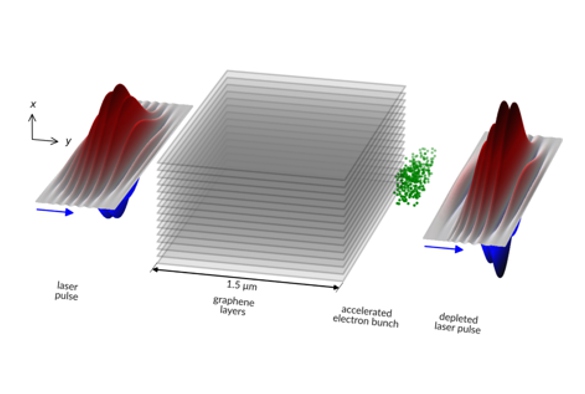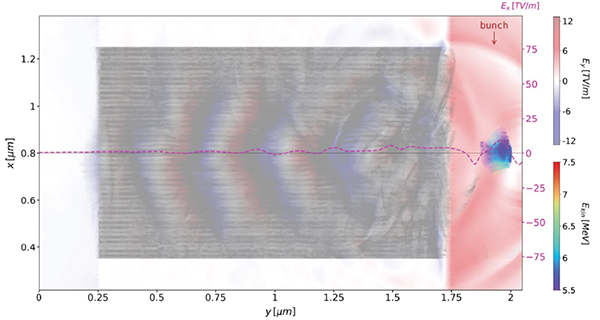TeV/m catapult acceleration of electrons in graphene layers

Laser Wakefield Acceleration (LWFA) in plasma is a well-known technique to accelerate electron bunches using infra-red (IR) intense laser pulses. Gas droplets of Helium or Hydrogen are easily ionized driving high longitudinal electric fields due to the collective motion of the electrons. The acceleration gradients are quite high, in the order of hundreds of GeV/m, but plasma instabilities specific to ionized gases prevent LWFA from becoming a robust alternative to conventional high-energy accelerators.
Solid-state crystals have long been considered theoretically as ideal targets. In combination with X-ray pulses these could ionize the crystalline lattice and unleash TV/m electric fields. In a paper recently published in Nature Scientific Reports led by LIV.DAT student Cristian Bonţoiu, it has been shown numerically that nanomaterials, such as graphene, could be ionized by intense ultra-violet laser pulses and drive resonant acceleration of electrons.
Recent nanotechnology advances enable fabrication of layered structures with controllable inter-layer gap, giving ultra-violet (UV) lasers access to solid-state plasmas which can be used as medium for electron acceleration. By using a linearly polarized 3 fs-long laser pulse of 100 nm wavelength and 1021 W/cm2 peak intensity electron bunches can be accelerated along a stack of ionized graphene layers.
The new injection scheme, which was studied using Particle In Cell (PIC) simulations, relies on plasma edge oscillations, whose amplitude depends on the distance between the graphene layers. Plasma edge oscillations have never been used before for trapping ultra-low-emittance electron bunches. Simulations indicate that in certain conditions, plasma edge oscillations can be underdamped, leading to several electron bunches being injected with a very high repetition rate of 1 fs. In addition, due to the high solid-state plasma density acceleration gradients are in the order of a few TV/m.

Accelerated electron bunch shown as it leaves the graphene layered target (Image credit: Bontoiu et al., Sci Rep 13, 1330 (2023) CC BY 4.0)
The catapult phenomenon described in this article offers a promising path towards the generation of sub-femtosecond-long electron bunches with a mean kinetic energy of several MeV. This shows exciting prospects for delivering the shortest electron bunches ever produced in the laboratory with excellent potential to advance ultra-fast electron diffraction techniques beyond current limits. Another potential application is the generation of THz magnetic impulses with the current techniques aiming for time resolutions in the order of tens of fs.
Overall, this work demonstrates that laser-wakefield acceleration in solid-state plasma can be achieved without the need for X-ray lasers as previously thought, and therefore has the potential to direct current research on novel acceleration techniques towards using UV laser pulses and layered nanomaterials.
Further information:
Bonţoiu, C., Apsimon, Ö., Kukstas, E. et al. TeV/m catapult acceleration of electrons in graphene layers. Sci Rep 13, 1330 (2023). https://doi.org/10.1038/s41598-023-28617-w
*(Image credit: Bontoiu et al., Sci Rep 13, 1330 (2023) CC BY 4.0)